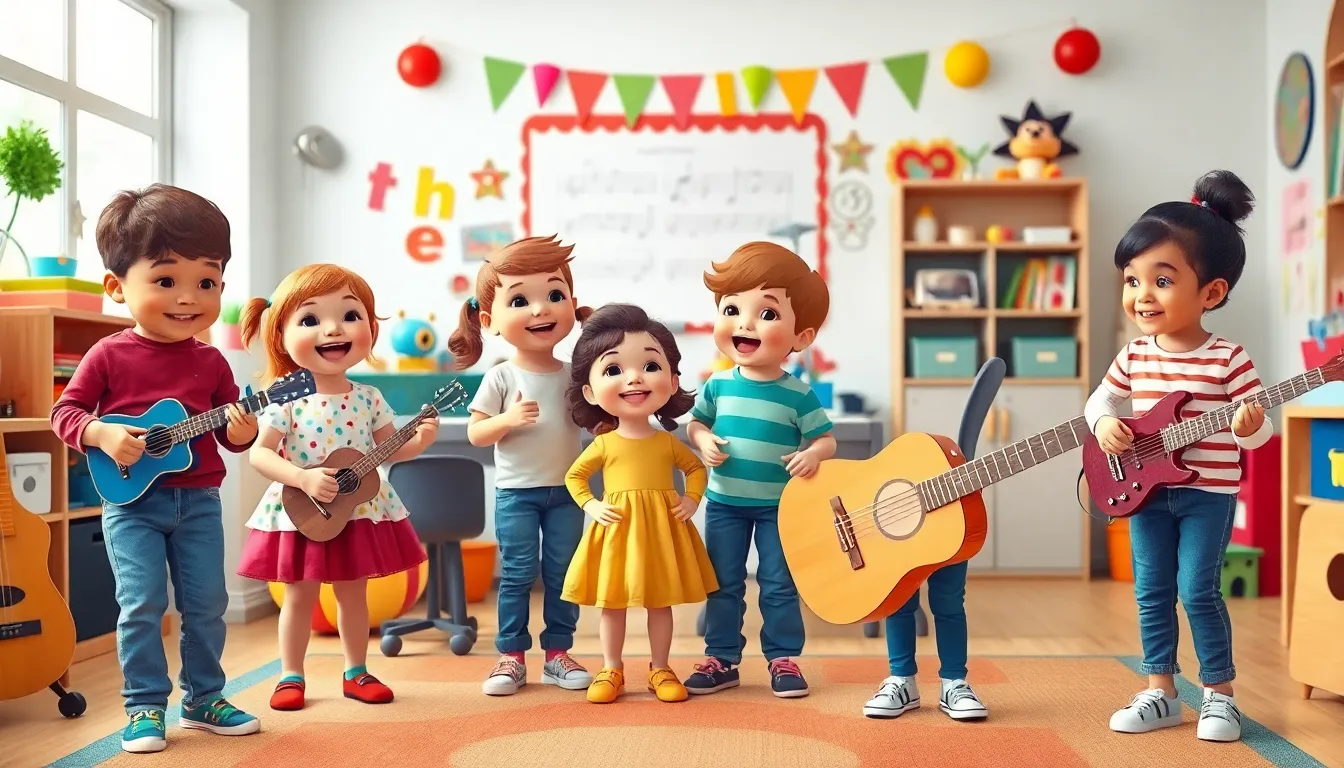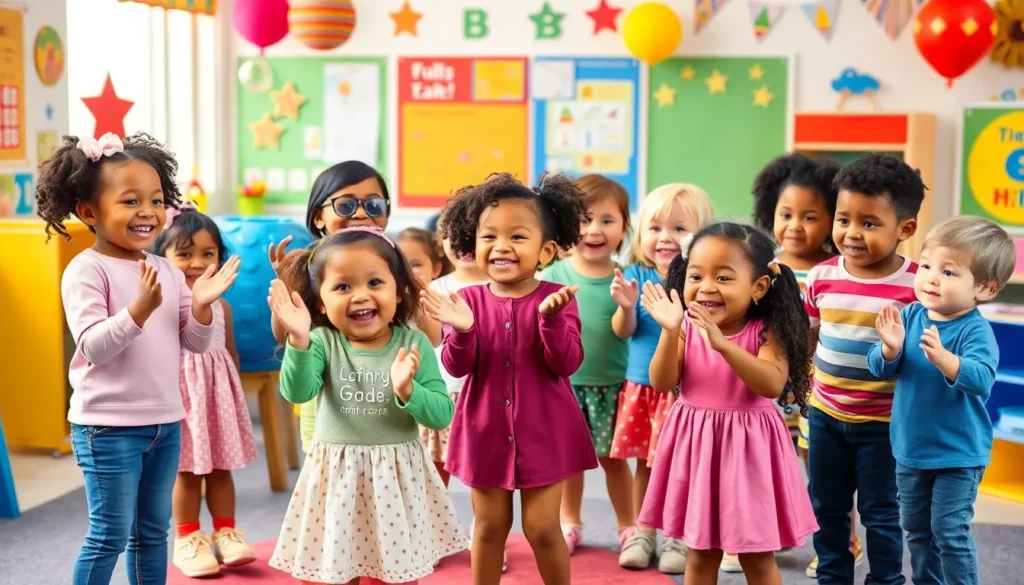Table of Contents
TogglePreschoolers love to sing, and what better way to ignite their imaginations than with catchy rhyming songs? These delightful tunes not only entertain but also boost language skills, memory, and creativity. Picture this: a room full of giggles as little ones bounce around, belting out rhymes that stick like peanut butter on a summer day.
Importance Of Rhyming Songs For Preschoolers
Rhyming songs play a crucial role in preschoolers’ early development. These engaging melodies offer various educational benefits that contribute to children’s growth.
Cognitive Development Benefits
Rhyming songs stimulate cognitive development in young children. They enhance memory skills through repetition and pattern recognition. Engaging with these songs encourages critical thinking and problem-solving abilities. Regular exposure to rhymes helps children identify sounds and connect them to words. This connection strengthens their understanding of language structure, fostering better cognitive functions.
Language Skills Enhancement
Language skills improve significantly when preschoolers sing rhyming songs. These catchy tunes introduce new vocabulary and phonemic awareness. Singing along aids in pronunciation and articulation of words. Children instinctively learn syllable patterns, which support their speaking and reading abilities. Listening to rhymes also encourages communication, allowing preschoolers to express themselves clearly.
Popular Rhyming Songs

Rhyming songs capture the hearts of preschoolers, promoting joy and learning through music. Below are some popular categories of these engaging tunes.
Classic Nursery Rhymes
Classic nursery rhymes stand the test of time. “Twinkle, Twinkle, Little Star” invites children to ponder the night sky while learning rhythm and melody. Another favorite, “Humpty Dumpty,” introduces storytelling through rhyme, helping kids enhance memory skills. “Mary Had a Little Lamb” offers repetition, reinforcing language patterns that aid comprehension. Each of these rhymes holds cultural significance and fosters early language development.
Modern Rhyming Favorites
Modern rhyming favorites resonate with preschoolers today. “Baby Shark” captivates young audiences through catchy repetition and a simple storyline. “The Wheels on the Bus” engages children in interactive singing and movement, stimulating creativity. “We’re All in This Together” from a popular children’s show promotes teamwork and camaraderie. These contemporary songs not only entertain but also introduce new vocabulary and reinforce social skills, making them essential for early childhood education.
Engaging Activities With Rhyming Songs
Rhyming songs provide numerous engaging activities for preschoolers. These activities not only entertain but also promote learning through interaction.
Sing-Alongs and Movements
Singing along to rhyming songs encourages preschoolers to participate actively. Each child can mimic movements associated with lyrics, enhancing physical activity. Dancing while singing fosters rhythm and coordination skills. Group sing-alongs strengthen social bonds among children as they share joyful experiences. Repetitive sounds in these songs help reinforce language understanding. Educators often use popular songs like “The Wheels on the Bus” for this purpose. Children delight in performing familiar actions, making learning enjoyable and memorable.
Craft Ideas Inspired By Songs
Crafting activities linked to rhyming songs allow children to express creativity. Creating visual representations of song themes enhances comprehension. For example, after singing “Mary Had a Little Lamb,” children can make lamb masks or puppets. Art projects utilizing colorful materials stimulate fine motor skills. Generally, crafts related to songs deepen cognitive connections and encourage discussions about the song’s narrative. Hands-on activities complement musical learning, solidifying language acquisition and thematic understanding. Engaging crafts and songs together cultivates an enriching learning environment in preschool settings.
Tips For Teaching Rhyming Songs
Teaching rhyming songs engages preschoolers in fun, interactive learning. Children thrive in an environment filled with music and creativity.
Creating A Fun Learning Environment
To create a fun learning environment, incorporate vibrant visuals and props. Colorful decorations and puppets can capture children’s attention. Encourage movement by allowing kids to dance and act out lyrics. Engaging songs can be complemented by dance routines that enhance enjoyment. Furthermore, group activities foster cooperation and connection among preschoolers. Involving families by inviting them to participate during sing-alongs can deepen community ties. Tailoring songs to various themes ensures that learning feels relevant and exciting. Adaptations for different settings, such as outdoor spaces or classrooms, keep the experience fresh.
Utilizing Repetition and Rhythm
Repetition serves as a powerful tool in teaching rhyming songs. Songs with repetitive phrases help children anticipate what comes next. Familiarity with patterns reinforces memory retention and comprehension. Encouraging children to sing along strengthens their confidence and enhances participation. Utilizing clapping or stomping along with the rhythm integrates physical activity. Connecting music to specific concepts, such as counting or colors, supports broader learning objectives. Ultimately, achieving a balance of fun and education through rhythm encourages preschoolers to engage willingly in musical experiences.
Rhyming songs are more than just enjoyable tunes for preschoolers. They serve as vital tools in early childhood development by enhancing language skills and cognitive abilities. The blend of music and movement fosters a joyful learning environment where children can thrive.
Incorporating these catchy songs into daily routines not only entertains but also supports vocabulary growth and social skills. Engaging activities paired with rhymes further enrich the experience, making learning interactive and fun.
By embracing the power of rhyming songs, caregivers and educators can create memorable moments that lay the foundation for lifelong learning and creativity.







